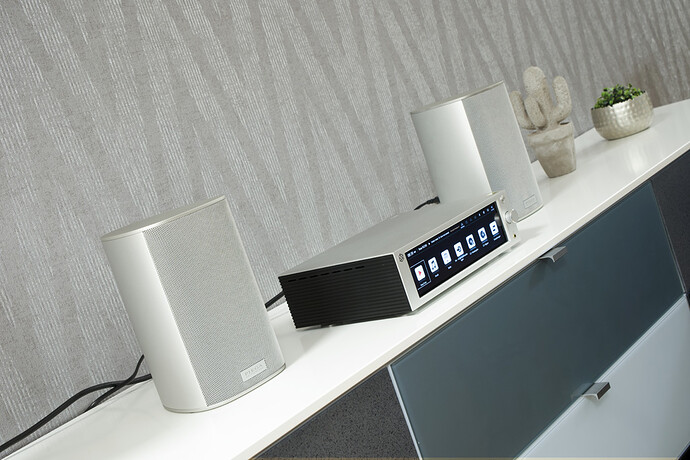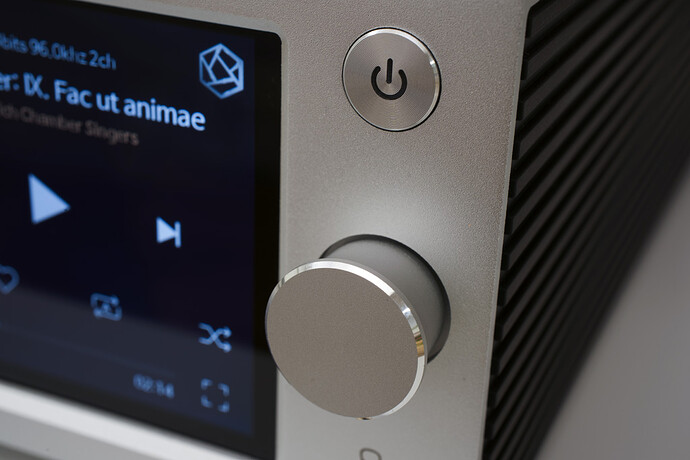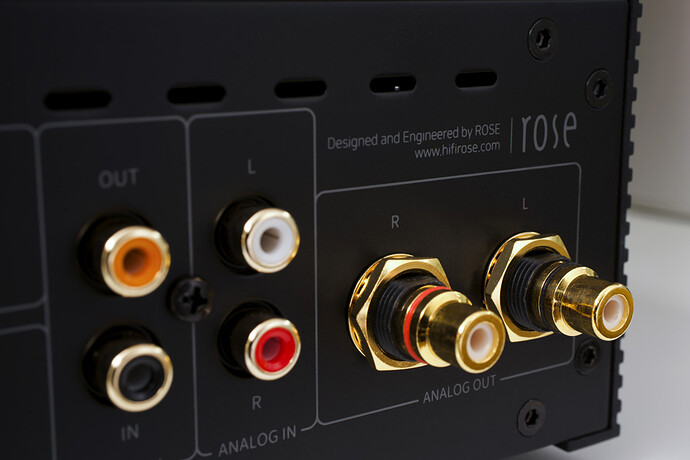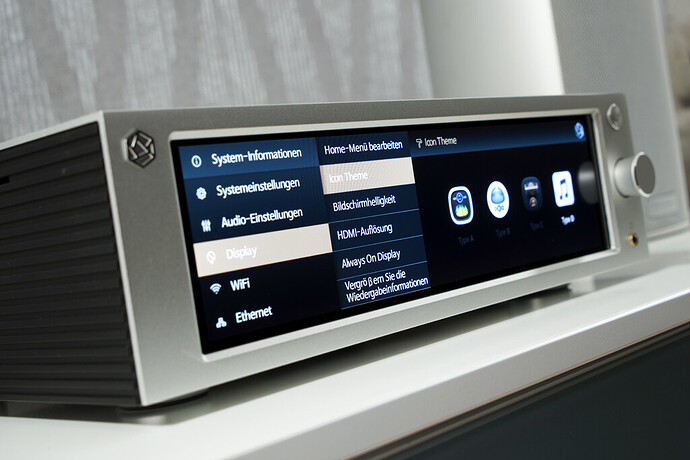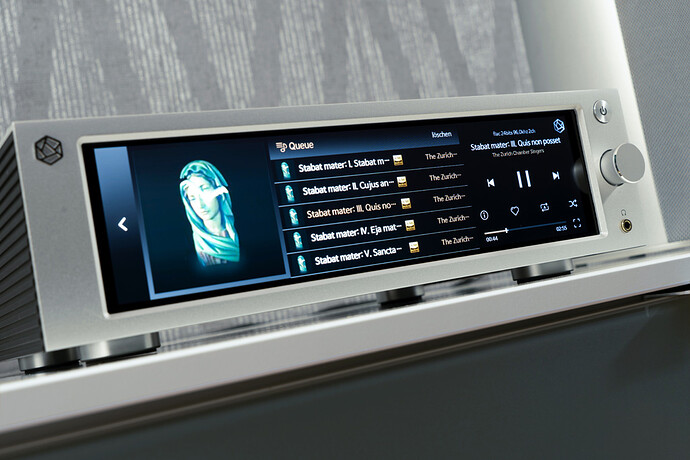At Rose, great design and good sound always go hand in hand. This also applies to the new RS250. The streaming DAC wants to stir up the compact class and does not only make use of an eye-catching appearance, but above all an enormous variety of functions. Combined with its unique operating concept, Rose wants to offer a high-quality control center for lean system concepts. We have undertaken the latest prank by the Korean manufacturer in a practical test.
Especially in combination with a pair of active boxes, the RS250 can show its talents. In a lean setup, it can be used as a server, player, DAC and prepress.
The operation of entertainment electronics directly on the device in question has become a rarity. In the meantime, even simple displays have been banned from the design language of many devices. In some cases, current audio systems only offer a lost-looking LED to visually inform the user. Rose is the complete opposite. A large display is not only part of the design concept, but is an integral part of the operation. Even with the rather small RS250, which is less than 30 centimeters wide, a touchscreen therefore takes up most of the front of the device. Here the functions can be selected, the libraries can be browsed, outputs and inputs can be switched through and all option menus can be operated. In short: practically everything you can do with the RS250 can be set directly on the device.
Becoming
All three control elements of the RS250 offer a nice feel. The position of the finger on the screen is precisely recognized. In combination with the well-dimensioned buttons, the menus can be operated very easily. The standby button may have a little more play than would have been necessary, but it offers a pleasant pressure point and acknowledges inputs with a nice, mechanical click. The volume control is also comfortable to hold, offers enough resistance and, thanks to its notches, can be used precisely. In addition to the large screen, it is the elegant housing of the RS250 that attracts attention. The top, front panel and the front part of the bottom are made from a single piece of aluminum. Accordingly, there are no joints or screws to be seen here. The small streamer looks like it is made from one piece. At the same time, the housing contributes to thermal compensation, so that the Rose does not need an active fan.
The rotary control for the volume and the standby button are the only physical control elements of the device. Just like the touchscreen and the rest of the housing, they offer a pleasant, high-quality feel.
Unbound
With the black plastic side parts, a little color contrast comes into play. By avoiding a completely metallic housing, Rose was able to move the antennas of the RS250 inside. So no unsightly plastic stubs or even large dongles disturb the elegant, straightforward look of the compact system. WLAN is therefore the first choice for integrating the device into the home network. In addition, the Bluetooth connection is an important part of the wireless capabilities of the Rose. On the one hand because it enables a quick connection to the smartphone to be created. It is also important for communication with the remote control supplied. The slim control unit also uses Bluetooth and can therefore be used without direct line of sight to the device.
Slimming diet
Unlike the Rose 201E, which is designed as an all-in-one system, the RS250 does not have its own amplifier. It is intended for users who either already have suitable power amplifiers or prefer to work with active speakers. Thanks to its compact housing, the RS250 can be easily combined with active bookshelf speakers, for example on a sideboard. In order to keep the setup as lean as possible, you can even do without a separate NAS. The device can be upgraded to a server in just a few steps. There is a flap on the underside behind which there is a SATA hard disk connector. Here, 2.5-inch SSDs can be used, which can offer up to 4 terabytes of storage space. With a Phillips screwdriver in hand, this can be done in a few minutes.
In addition to the installation of an internal hard drive, mass storage devices can also be connected via USB. The RS250 then offers all the important inputs for signal transmission from external sources.
Rose RS250 - Digital diversity in the smallest of spaces
If you prefer to use it without using tools, you can also connect external hard drives and memory sticks to the USB port on the back. The RS250 also offers a USB-B input for connecting to the laptop. S / PDIF signals can be optical or coaxial, both in and out of the device. There is also an analog cinch input. While external DACs can also use the USB output, the focus of the device is clearly on the use of the internal converter. With the unbalanced output, the RS250 can be used with amplifiers and active speakers. For use as a desktop system, there is also a 3.5 millimeter headphone jack on the front. If you want to continue using your CD collection in addition to music files, you can connect an external drive. In addition to playback, the system also enables ripping. Thanks to these possibilities, the RS250 has what it takes to become the control center of the living room.
What for the eye
A television can also be connected to the device thanks to the HDMI port. However, this is not an input where the television sound is output through the system. Instead, the TV can be used for the video functions of the RS250. In addition to music, the system is also able to play back films and other video clips. The function is also interesting for music fans, as two of the RS250’s apps, RoseTube and Tidal, are intended to play music videos. While these are part of the streaming service at Tidal, RoseTube is a music-focused front end for YouTube. Numerous suggestions for different genres are displayed, but every video on the platform can be accessed via search. And even without advertising.
The output signal of the RS250 can be adapted according to the application. If you switch off the volume control, the system offers different voltages to choose from.
Stream for your life
In addition to these two streaming services, Rose offers other options for listening to music. Qobuz rounds off the range of subscription services with its catalog of HiRes audio, while a podcast service and an Internet radio service offer access to even more content. With RoseFM, there is also an additional radio service on board. A classic tuner is simulated on the screen, which is a very cool solution. However, the service only offers access to channels from Switzerland, Korea, the USA and the UK. The last streaming service in the group, called Bugs, is only available in Korea. Here and there, the sometimes awkward localization of the system software is noticeable. Some translations in the German language version are a bit bumpy. This does not affect the ease of use of the RS250 and its enormous variety of functions. Nevertheless, there is always room for improvement, which is made here with regular system updates.
Control freak
The operation of all functions via the large display works wonderfully. The screen does not recede even when typing boldly. In addition, all buttons are dimensioned so that you can always hit your target well. Only when a keyboard is displayed, for example when searching for a title, does it get a little narrower. But even then, the input works extremely precisely. Android users will quickly find their way around the RS250, because the streaming DAC also uses a modified version of the operating system. Thanks to the app structure and clear menu navigation, it is easy to maintain an overview despite the large range of functions. With a tap on the Rose logo in the top right, you always come back to the main menu. The app for tablets and smartphones called Rose HiFi is also great to use.
Practically all functions of the streaming DAC can be operated with the Rose HiFi app. Thanks to a clear interface, the training period required is quite short.
a matter of taste
As soon as Queen’s “A Kind of Magic” has been selected, the metadata and cover appear large on the screen. Those who prefer a classic look can also fade in a simulated VU meter at the push of a button, which is available in several color variants. Overall, many aspects of the user interface can be customized. For example, the app symbols in the main menu of the RS250 can be adapted in different styles. The order of the apps can also be changed, or functions that are not used can be completely hidden. Ultimately, you can even choose from a variety of clock designs for standby mode. In the game, however, I opt for the large-scale presentation of the current title, while the RS250 proves its sonic qualities. In the eponymous song on the album, the streaming DAC puts a lot of effort into playing the crisp eighties drums. The sticks hit their target precisely and dynamically, while a slight reverb effect underlines the open stage presentation.
Strength of character
Freddie Mercury’s vocals are then set up against this backdrop. The RS250 acts wonderfully soulful and implements the charismatic voice of the singer with great diversity. The good voice reproduction is also convincing in the melancholy “Who Wants to Live Forever”. In addition, the rose finds a great mixture of a large, open stage, with differentiated components, and at the same time abundance. You can record anything without the game looking stretched. At the beginning there is a gentle organ playing in the background, while Mercury is in the center. Far distant, dull drum beats sound between the text passages. The initially cautious strings with their creamy sounds increasingly take the lead. Together with Mercury and the beginning winds, the arrangement of the National Philharmonic Orchestra continues to climb. The RS250 can never be disturbed by this. Instead, it delivers lots of fine details and remains pleasantly transparent.
In the options menu you can choose your favorites from various designs. The offer ranges from elegantly modern to juvenile and colorful.
Moving
The recording itself is primarily responsible for the richness of detail. However, it is the job of the digital-to-analog converter to get the subtleties out of the signal. Rose is betting on its latest prank, unlike the original version of the larger RS150, no longer on chips from AKM, but instead uses ESS. This makes the RS250 look pleasantly fresh and it gives albums a nice flow in every resolution. That goes well with the lively dance tracks on Jamiroquai’s “High Times”. With “Cosmic Girl” a powerful bass line pushes its way into the room with pressure. In the downturn, however, the powerful bass seems to lose focus a little here. Nevertheless, it is fun, especially when the finely resolved cymbals are added. Together with the good, present voice reproduction, there is lively sound here, in which the volume is increased again and again in order to record everything even better.
Under power
With “Deeper Underground” the RS250 pulls an ace up its sleeve. In the intro, the streaming DAC reveals some subtle effects that I had never noticed before. Their discovery is only possible through the dark background of the stage. The linear power supply unit, which supplies the Rose with energy, certainly has its part in this. Not an everyday occurrence in a compact system, but the manufacturer would like to make use of the sonic advantages of a good power supply. A good decision. After the rather quiet intro, the powerful guitars hit me almost a little unprepared. The rich pressure and the deep tuning of the track contrasts with the lightness and freshness of the RS250. In combination, the game appears powerful and lively, without any form of indolence.
During playback, the queue, the cover and metadata of the current song, or even simulated VU meters can be shown on the large display.
Sound machine
Of course, all genres benefit from these strengths, especially if you feed the RS250 with HiRes material. It seems as if the additional bits open up the stage a little further, improve the depth gradation even more and present the playing of the Tingvall Trio in “Cirklar” even more differently. Every stroke of the piano snaps well defined out of the silence, while the crisp drums give the right propulsion. If the well-timed inserts initially set dynamic accents, the elements convince in the finish with great timbres. The plastic cymbals in “Skånks Blues” in particular benefit from this, accompanied by the physical foundation of the perfectly dosed bass range. Everything seems to be consistent with the RS250. Without effort and always neutrally, he reliably implements the signals given to him.
Conclusion
Rose becomes a fixture in the high quality media player market. The RS250 is an excellent streaming DAC that impresses with its innovative design, easy-to-use controls and great sound. The clever system also offers an enormous variety of functions. From the integration of the smartphone to extensive streaming options and even use as a full-fledged media server: the RS250 is always there. Together with the good audio technology and its numerous interesting features, even beyond pure music reproduction, Rose offers all the advantages of its flagship systems in a modern compact format.
Test & Text: Philipp Schneckenburger
Photos: Max Kostyra
Summary
Overall grade: Highlight
class: Reference class
Price / performance: excellent
sound
99 of 100
practice
99 of 100
Furnishing
98 of 100


